I. Introduction
II. Definition of Physical Impairment
III. Impairment Evaluation (Assessment System)
IV. Permanent Impairment Rating and Disability Rating
V. Damage to the Trigeminal Nerve and Permanent Impairment Rating
1. Innervation of the trigeminal nerve
1) Ophthalmic nerve: The first branch of the trigeminal nerve; innervates the eyeballs and their adnexa (vascular tunic and conjunctiva), skin of the frontal and parietal regions, and nasal mucous membrane.
2) Maxillary nerve: The second branch of the trigeminal nerve; responsible for the sensations of the maxillary skin, teeth, gum, and mucous membrane and palate.
-
3) Mandibular nerve: Its motor fibers innervate the masticatory muscles and other small muscles; its sensory fibers innervate the mandibular skin and teeth and tongue mucous membrane. The following are the nerve branches:
(1) Meningeal branch: Passes through the foramen spinosum and enters the intracranium; innervates the dura mater.
(2) Masseteric nerve: Branches from the mandibular nerve above the lateral pterygoid muscles; crosses the mandibular notch to the deep surface of the Masseter muscle and innervates the Masseter muscle.
(3) Deep temporal nerve: One of the motor branches of the mandibular nerve; consists of anterior and posterior and innervates the temporal muscle.
(4) Lateral pterygoid nerve: One of the motor branches of the mandibular nerve; innervates the lateral pterygoid muscle.
(5) Medial pterygoid nerve: One of the motor branches of the mandibular nerve; innervates the medial pterygoid muscle.
(6) Buccal nerve: Innervates the skin over the cheek, buccal gingiva of mandibular molars, and buccal mucosa.
(7) Auriculotemporal nerve: It passes medially to the lateral pterygoid muscle and to the neck of coronoid process, and then turns superiorly posterior to the temporomandibular joint. It passes through the parotid gland, and then moves superiorly in front of the external acoustic meatus. It runs with the superficial temporal artery, innervates the skin of the temporal regions and its parotid branches originating in otic ganglion, and serves as secretomotor fibers for the parotid gland.
(8) Lingual nerve: It runs along the lateroinferior border of the tongue to the apex of the tongue, including the chorda tympani nerve of the facial nerve adjacent to the origin. It provides taste sensation to the anterior 2/3 part of the tongue as well as secretory function of the submandibular and sublingual gland.
-
(9) Inferior alveolar nerve: It branches at the back of the lingual nerve, and then enters the mandible via the mandibular foramen along with inferior alveolar artery and vessel. The nerve branches are as follows:
① Mylohyoid nerve: It branches from the inferior alveolar nerve just before it enters the mandibular foramen. It has motor fiber that innervates the mylohyoid muscle and sensory fiber that innervates the skin of the submental and submandibular space.
② Dental branches: Sensory fiber that innervates the mandibular teeth, buccal gingiva, and periodontium.
③ Mental nerve: As a sensory branch of the inferior alveolar nerve, it emerges at the mental foramen beneath the mandibular second premolar. It innervates the lower lip mucosa and skin, mandibular anterior teeth, and skin of the chin.
2. Medical disputes on paresthesia associated with inferior alveolar nerve damage
1) In 2009, a survey on paresthesia after third molar extraction was conducted among dentists across the nation. The results of the survey showed that, of the 2,577 cases of inferior alveolar nerve paresthesia after third molar extraction, the symptom persisted for 2 years or longer in 8.7%; of the 713 cases of lingual nerve paresthesia, the symptom lingered for 2 years or longer in 10.7% of the cases.
2) Of the 3,290 cases of paresthesia after third molar extraction, the symptom persisted for 2 years or longer in 172 cases, 29.7% of which showed a reduced degree of paresthesia; the area of paresthesia decreased in 8.7%, whereas there was no difference in 43.6%. Those who answered "not sure" accounted for 18%.
3) Of those who continued to suffer from paresthesia for 2 years or longer, 56.4% experienced inconvenience in their daily lives; 28.5% were not affected by the symptom in their everyday lives, whereas 2.9% experienced extreme inconvenience that they were unaware of drooling at the mouth. At least 9.3% replied that they were not sure. (Journal of the Korean Dental Association 2009, Vol. 47[4]).
4) Currently, the Court applies the evaluation guideline for trigeminal nerve damage when evaluating mandibular nerve damage and associated permanent impairment. The McBride and AMA guidelines discuss only damage to the entire trigeminal nerve. Recent trends focus on neuralgia and acclimation to nerve damage instead of simply evaluating paresthesia. The State Tort Liability Act has no evaluation criteria for either trigeminal nerve or inferior alveolar nerve; it simply calculates the impairment rate as 30% when there are limitations to mastication and language ability, 15% in case of severe local neurological symptom, and 5% in case of persistent neurological symptom. Besides, the guidelines do not reflect any difference in the rate of loss of labor capacity attributed to job difference. Moreover, in the guideline, the differences in the rate of loss of labor capacity are too great among different classes; hence the need to suggest evaluation criteria that are reasonable and specific to inferior alveolar nerve damage.
3. Calculating the rates of impairment and labor capacity loss due to inferior alveolar nerve damage
-
1) McBride evaluation guideline
-
① Evaluation guideline
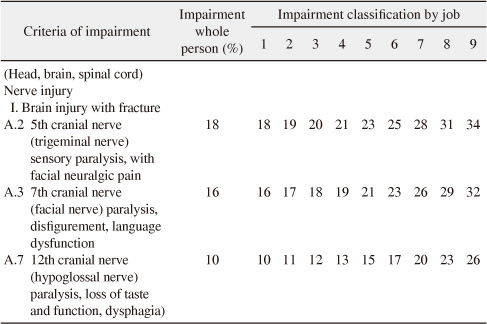
-
② Application of rates of impairment and labor capacity loss due to sensory paralysis of one side of the lower lip
- Selection of impairment criteria: Apply 18% impairment rate for the whole body caused by fifth cranial nerve paralysis.
- "18%" is applied when both sides of the trigeminal nerves are damaged. Only 9% - half of 18% - is applied to the case of lower lip paralysis on one side.
- "9%" is when the entire trigeminal nerve is damaged. Since the mandibular nerve is one of the three branches of the trigeminal nerve, only 3% - 1/3 of 9% - is applied to mandibular nerve damage.
- In terms of the rate of loss of labor capacity of the average workers who work inside or outside buildings, both the rate of physical impairment and job coefficient are considered. In this case, 20% loss of labor capacity can be applied in the table of job coefficient (Category 3 Nervous System). Therefore, 20%×1/2×1/3=3.3% can be applied if it is calculated in the same way as that for calculating the rate of physical impairment.
- The rate of physical impairment for lower lip paralysis on one side is 3%; the rate of loss of labor capacity may be calculated as 3.3%.
-
-
2) AMA Impairment Guideline
-
① 4th edition of AMA Impairment Criteria (1993)
-
- Assessment of rates of impairment and labor capacity loss due to sensory paralysis of one side of the lower lip.
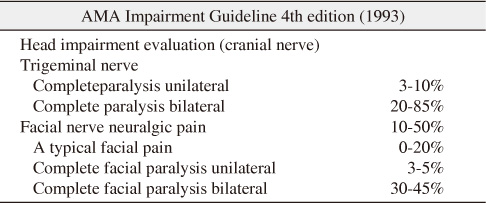
• According to the table for evaluating the rate of head impairment of the AMA impairment criteria 4th edition, 3-10% of "trigeminal-full loss of sensation on one side" class may be applied.
• 3-10% impairment rate is applied to all three branches of the trigeminal nerve. Since sensory paralysis of the lower lip involves only one of them, i.e., the mandibular nerve, 1/3 may be applied.
• According to the AMA 4th edition, the rate of impairment may be 1-3.3%.
-
-
② 5th edition of AMA Impairment Guideline (2000)
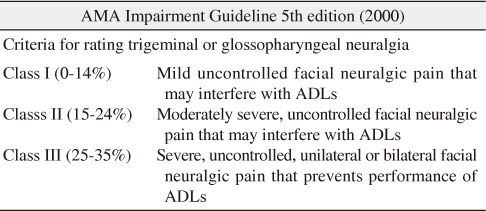
- Sensory evaluation of pain, heat, tactile, or both sides of the face is performed by comparison.
- When assessing sensory paralysis due to damage to one side of the mandibular nerve, half (since one side) of the rate for the entire trigeminal nerve damage and 1/3 (since mandibular only) are applied at the same time.
- Rate of impairment for class I (0-14%): 0-2.3%
- Rate of impairment for class II (15-24%): 2.5-4%
- Rate of impairment for class III (25-35%): 4.2-5.8%
- In the aforementioned case, if there is only paralysis of the lower lip, 0-2.3% of the rate of impairment may be applied, 2.5-4%, if accompanied by moderate facial pain, and 4.2-5.8%, if accompanied by severe facial pain.
-
-
3) National Compensation Law (State Tort Liability Act)
In the enforcement ordinance of the Act, 1-14 classes of rates of labor capacity loss are defined. The criteria of the Act are a full adoption of the former Japanese system. The criteria are not reasonable in many ways - job influences are not considered at all, degree of impairment is abstract, and differences in the rates of labor capacity loss are too great among different classes. The assessment of the rate of labor capacity loss according to the number of dental prostheses after tooth loss is quite unreasonable and is not very much used today. In modern dentistry, a lost tooth can be restored with dental implant, which can retain 80% of masticatory ability of a natural tooth and whose aesthetics and convenience are on a par as those of a natural tooth. Therefore, it is not reasonable to assess the rate of labor capacity loss of dental implant restoration as in the past.-
① Criteria for impairment evaluation according to the State Tort Liability Act
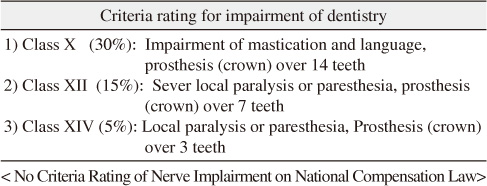
-
② Assessment of the rates of impairment and labor capacity loss due to sensory paralysis of the lower lip
- The criteria of the State Tort Liability Act do not discuss inferior alveolar nerve damage, so it is not possible to determine the rates of impairment and labor capacity loss by the Act. So far, "the rate of labor capacity loss is 5% uniformly for those who have persistent local neurological symptoms," but that needs to be changed.
-
-
4) Impairment evaluation criteria of the Korean Academy of Medical Sciences
- In the impairment evaluation criteria published by KAMS in 2011, there are no detailed evaluation criteria with regard to trigeminal nerve. Thus, it is not possible to assess the damage to the sensory fiber of the trigeminal nerve, such as lower lip paralysis. -
5) Guideline of the American Association of Oral and Maxillofacial Surgeons
① Criteria for assessing impairment: The criteria, based on the 6th edition of the AMA criteria for impairment assessment, were suggested in 2008 as a guideline for assessing impairment in the oral and maxillofacial areas.
-
② Evaluating the impairment for facial neuralgia accompanied by lower lip paralysis related to inferior alveolar nerve damage.
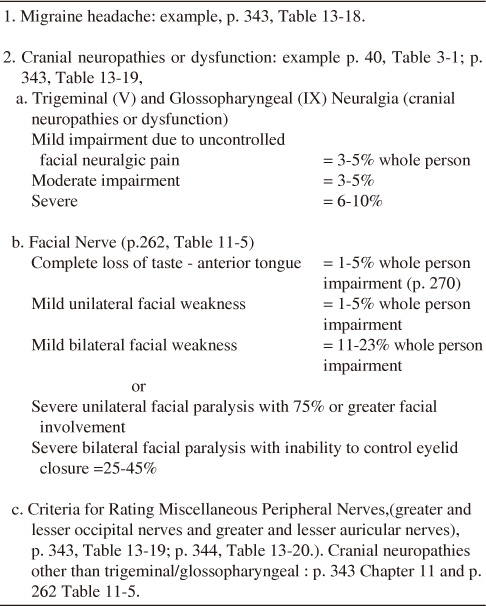
- Article 2-a of the AAOMS guideline can be applied.
- Since there is no indication for one side, half of the trigeminal nerve-related values may be applied. The calculation for the rate of impairment is as follows:
- Mild-moderate impairment accompanied by uncontrolled facial neuralgia: 1.5-2.5%
- Severe impairment accompanied by uncontrolled facial neuralgia: 3-5%
VI. Conclusion





 PDF
PDF ePub
ePub Citation
Citation Print
Print


 XML Download
XML Download